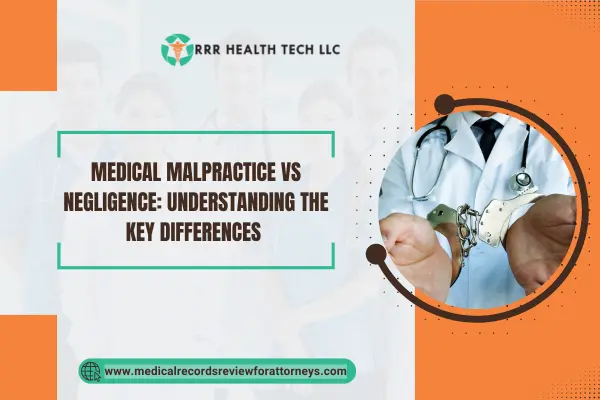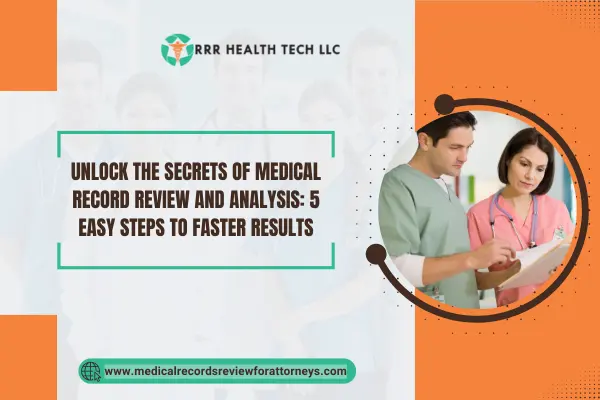
In stroke and internal injury lawsuit, the medical reviews serve as the foundation of legal winning strategies. It doesn’t matter if it is a stroke-related disability claim or internal injuries because of negligence, attorneys need clear, comprehensive, and precise medical records to strengthen their cases.
This blog discusses how medical record reviews help in incisional strokes and internal injury lawsuit while also offering guidance for attorneys faced with these challenging medical-legal battles.
Introduction
The medical consequences of strokes and internal injuries could result in life-altering effects affecting an individual’s life. In a legal context, causation, damages, and long-lasting impact must be meticulously demonstrated through a complete set of medical records.
For attorneys dealing with clients suffering from strokes or internal injuries, knowing the symptoms is half the battle won, and the care and treatment come next, and that’s where expert medical reviews come in handy.
Understanding Stroke and Internal Injury
Most stroke survivors live with a plethora of complications. Stroke has the potential to cause a blend of long-lasting symptoms, including post-stroke fatigue, emotional and cognitive symptoms of stroke, subtle cognitive post-stroke changes, and physical symptoms post-stroke.
In contrast, internal injuries stem from different types of traumas, including:
•Internal injuries from car accidents
• Internal injuries from falling
• Internal injuries at work
• Violent assault, internal injuries
• Severe dog bite internal injuries
• Internal injuries in sports
They may lead to dire consequences such as:
• Bleeding in the brain
• Bleeding contusion in the lungs
• Injuries to the abdomen
• Abdominal organ injuries
• With internal bleeding, the kidney may also be injured
• Spleen injury
• Liver injury
All these injuries must be considered in detail and further investigated if internal injury lawsuit compensation is being claimed or if an internal injury lawsuit is filed.
Types of Strokes
• Ischemic Stroke: When arteries are blocked, blood flow to the brain is reduced, resulting in this stroke.
• Hemorrhagic Stroke: When vessels of the brain burst, bleeding occurs and gives this type of stroke.
• Transient Ischemic Attack (TIA): This is commonly called a mini stroke, which has temporary symptoms.
• Cryptogenic Stroke: This stroke has no cause noted.
• Brain Stem Stroke: This stroke takes a toll on both sides of the body, and loss of the ability to perform vital functions
It is important to bear in mind the various forms and symptoms of stroke when assessing stroke-related disability claims concerning developing point-of-litigation strategies.
Why Medical Reviews Matter in Stroke and Internal Injury lawsuit Cases?
Medical review helps attorneys:
• Exposing residual symptoms restricts potential employment opportunities for stroke survivors.
• Creating time frameworks for blunt or penetrating trauma and internal organ injury sequelae.
• Defining levels of functional incapacitation consequent to stroke.
• Spot underlying symptoms resulting from strokes that are overlooked in the preliminary assessments.
• Relate stroke symptoms differently observed in the patients’ longitudinal care to needs assessments.
Such reviews construct a coherent explanation out of intricately complex discrepancies, explaining the medical reasons behind claiming long-term disability post stroke or sustaining internal injuries while alleging the negligence of a third party.
Challenges Attorneys Face in Stroke and Internal Injury lawsuit Cases
Attorneys dealing with these claims often face:
• Contested set of obsolete work files containing complex medical jargon and undifferentiated vague medical terms.
• Missing documentation for stroke rehabilitation or post-stroke exhaustion.
• Paces of a retrospective chronicle of treatment template for trauma underlying internal injuries.
• Contradictory correlating records on the contemporary syndrome of inner injury, slow stroke stage diagnosis.
• Establishing causation of inner injury after establishing reckless negligence within a set chronic pathologic consequence.
All these difficulties may be addressed by conducting thorough medical examinations guided by specialized professionals, meeting every legal criterion.
Consequences of Strokes and Internal Injuries on Individuals
Both strokes and internal injuries can lead to:
• Strokes with long-term disabilities that may include difficulties with speech, thinking, movement, and mobility.
• Survivors of strokes struggle with fatigue, emotional volatility, and depression.
• Stroke sufferers may face a loss of income, which may lead to long-term difficulties with daily living activities.
• Medical conditions that can be life-threatening, such as internal bleeding, organ failure.
• Trauma that is psychological due to physically assaulting internal injuries or head-on collision car accident internal injuries.
Identifying these factors is essential to providing a comprehensive case for adequate compensation, legal remedy, and equity.
Tailored Rehabilitation Needs Following a Stroke or Internal Injury Lawsuit
Each stroke survivor or person with internal injuries has unique recovery needs:
• Rehabilitation of stroke patients may require physical, speech, and cognitive therapy, and retraining.
• Trauma victims of severe blunt force may require extensive care due to intra-abdominal injuries or intracranial bleeds.
• Cognitive aftermaths of strokes require occupational therapy.
• Internal workplace injuries from a stroke may need specialized treatment from an orthopedic or neurologist.
The attorney’s careful selection of the claimant’s medical documents, together with the client’s medical details, gives credence to the case of commensurable rehabilitation provisions.
Next Steps for Attorneys in Stroke and Internal Injury Lawsuit
To improve litigation outcomes, attorneys should:
- Bring together for consultation those who deal with the hypothesis of the case and the interpretation of the evidential materials.
- Accompanying emotional and cognitive symptoms of stroke also need to be documented as part of the symptoms of injury.
- Clarify features of the medical evidence concerning the mechanism of internal injuries and the incidence of negligence.
- Assess imaging studies and laboratory tests for the stroke and internal organ damage symptoms s/he noted.
- Capture the consequences of life activities participation concerning work, particularly focusing on the remaining capabilities for work post-stroke.
Conclusion
Medical records are crucial in the context of a civil dispute concerning stroke and internal injury lawsuit. It enables lawyers to untangle complicated medical narratives, illustrate the impact of disability stemming from stroke, and advocate for clients dealing with internal injuries and chronic symptoms from prolonged suffering. There is a need for careful consideration of the medical files, whether the client is a stroke survivor or a victim of internal injury lawsuit resulting from trauma. The file analysis can turn the tide in the case strategy.
Need expert medical reviews for your stroke or internal injury case?
Let RRR Health Tech support your litigation with thorough, accurate, and attorney-focused medical record review. Contact us today for a free consultation!


